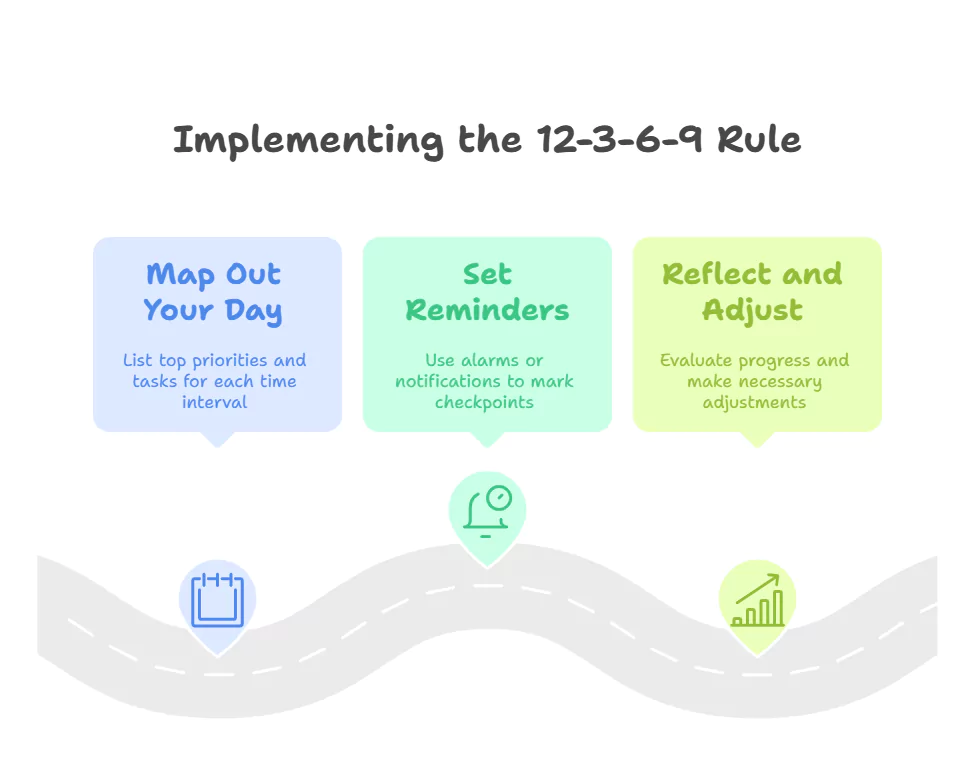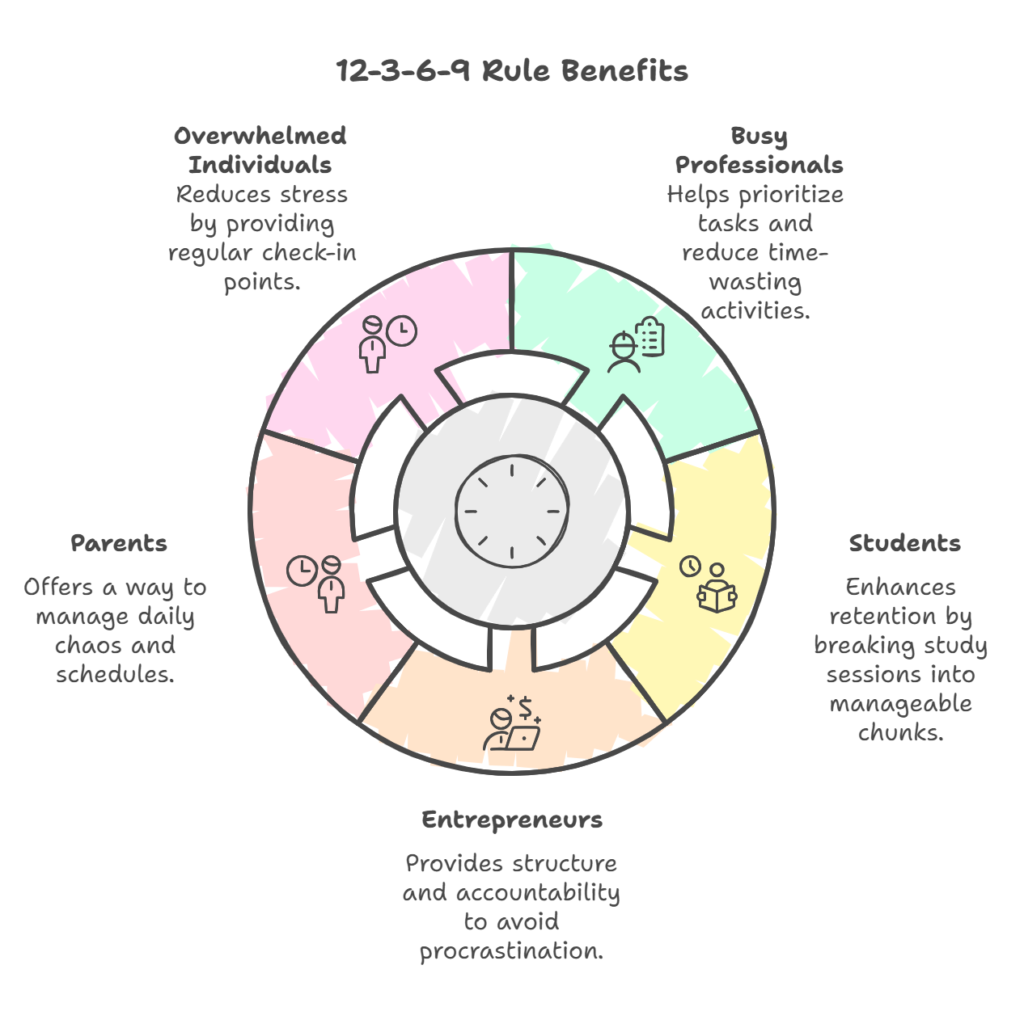Time management can feel like trying to catch smoke, right? One minute you’re all set to tackle your to-do list, and the next, the day’s gone, and you’re left wondering where the time went. That’s where the 12-3-6-9 Rule comes in. It’s this simple, super-smart time management hack that’s been making waves lately—and for good reason. Think of it like your daily compass, breaking your day into four manageable chunks so you can actually stay on track. It’s not magic, but it’s pretty close!
Table of Contents
What Is the 12-3-6-9 Rule?
The 12-3-6-9 rule is a time management technique that breaks your day into four key checkpoints: 12 PM, 3 PM, 6 PM, and 9 PM. These checkpoints act like little signposts to keep you on track, helping you reassess your progress, adjust priorities, and stay in control of your time.
How It Works
Every great day starts with a plan, right? Before you dive headfirst into work or life’s chaos, take a few minutes in the morning to map out your priorities. What absolutely has to get done? What can wait? It’s like setting the GPS before a road trip—you wouldn’t just start driving and hope for the best. Dr. Cal Newport, the author of Deep Work, swears by the power of starting your day with clear priorities. In fact, research from Dominican University found that writing down your goals can boost your chances of achieving them by a whopping 42%. So, grab a notebook or your favorite app and jot those priorities down.

The First Checkpoint: 12 PM
By the time noon rolls around, the day’s rhythm is already in full swing. This is your first chance to hit pause and check in: “How’s it going? Did I crush that morning task, or did something throw me off track?”
If the morning didn’t go as planned (and hey, it happens), this checkpoint is your chance to regroup. Maybe an unexpected meeting popped up, or a project took longer than you thought. No big deal—just adjust your afternoon goals to get back on course.
Example: Let’s say you wanted to finish drafting a report by 11 AM, but you only made it halfway. At 12 PM, decide to carve out another hour after lunch and push a less urgent task to tomorrow. Easy peasy.
Mid-Afternoon Check: 3 PM
Ah, the infamous afternoon slump. You know the one—when your energy takes a nosedive, and suddenly everything feels 10 times harder. That’s why the 3 PM checkpoint is so important. It’s like halftime in a game—a moment to regroup, reassess, and get your momentum back.
Studies show that productivity tends to dip between 2 PM and 4 PM. To counteract this, focus on tasks that require less brainpower or take a quick break to recharge. As productivity guru Chris Bailey says, “Managing your energy is just as important as managing your time.”
Pro Tip: Knock out a quick win at this checkpoint. Send that email, clean up your notes, or tick off a smaller task. It’ll give you a little motivational boost to carry you through the rest of the day.
Evening Wrap-Up: 6 PM
By 6 PM, most of us are winding down from the workday. This is your moment to tie up any loose ends. Did you hit your big goals? If not, what can you realistically finish before calling it a day?
Psychologists say that creating a clear end to your workday helps prevent mental clutter and stress. It’s all about boundaries. Use this checkpoint to decide what can wait until tomorrow and give yourself permission to officially clock out.
Reflect and Reset: 9 PM
The final checkpoint is all about reflection. At 9 PM, take a few minutes to look back on your day. What worked? What didn’t? What could you do differently tomorrow?
This isn’t just a feel-good exercise—it actually works. A Harvard Business School study found that people who spent 15 minutes reflecting at the end of their day were 23% more productive over time. Plus, it’s a great way to clear your head before bed and set the stage for a killer tomorrow.
Benefits of the 12-3-6-9 Rule
1. Keeps You Productive Without Overwhelming You
Instead of juggling everything at once, this rule encourages you to focus on specific tasks during each block of time. It’s like cleaning one room at a time rather than tearing the whole house apart at once.
2. Makes You More Aware of Time
We’ve all had those days where you look up, and it’s suddenly 5 PM, and you have no idea what you’ve been doing. These checkpoints bring you back to reality, helping you stay mindful of how you’re spending your hours.
3. Encourages You to Take Breaks
Burnout is real, my friend. The 12-3-6-9 rule naturally builds in moments to pause, stretch, grab a coffee, or just breathe. These breaks aren’t just nice—they’re necessary to keep your brain from turning into mush.
4. Flexible Enough for Any Schedule
Whether you’re working a 9-to-5, studying for finals, or chasing toddlers around the house, this method adapts to your life. It’s more of a framework than a strict rulebook, which makes it easy to customize.
How to Start Using the 12-3-6-9 Rule

Step 1: Map Out Your Day
Start by listing your top priorities for the day. Break them into tasks that fit within the four intervals:
- Morning (before 12 PM): Handle deep-focus work or anything that requires creativity and energy.
- Afternoon (12 PM to 3 PM): Tackle meetings, calls, or easier tasks that don’t demand too much brainpower.
- Evening (3 PM to 6 PM): Wrap up loose ends and prepare for the next day.
- Night (6 PM to 9 PM): Wind down with personal time, hobbies, or relaxation.
Step 2: Set Reminders
Use your phone or a planner to mark the checkpoints. It doesn’t have to be fancy—a simple alarm or notification works just fine. These little reminders help you stay on track without being intrusive.
Step 3: Reflect and Adjust
At the end of each interval, take a minute to ask yourself: “What went well? What didn’t?” Adjust your next block accordingly. Think of it as fine-tuning your schedule in real time.
Who Can Benefit from the 12-3-6-9 Rule?
The 12-3-6-9 Rule isn’t some fancy tool reserved for productivity gurus—it’s a super simple system that anyone can use to feel more in control of their day. Whether you’re buried in work emails, tackling a study marathon, or trying to tame the chaos of daily life, this rule has your back. Let’s chat about who can get the most out of it and why it’s such a game-changer.

1. Busy Professionals
Got a packed calendar with meetings, deadlines, and a never-ending stream of emails? The 12-3-6-9 Rule is your new best friend. It forces you to stop, take a breath, and figure out what really matters right now.
Here’s the thing: studies show that almost 60% of the average workday gets eaten up by “busy work” like answering emails and attending unnecessary meetings. That’s according to a 2022 report by Asana. With regular check-ins throughout the day, you can call out those time-wasters and get back to the stuff that actually moves the needle.
2. Students
Let’s be real: studying for hours on end can be brutal. The 12-3-6-9 Rule breaks it up into smaller chunks so you don’t burn out or zone out. Regular breaks don’t just keep your energy up—they actually help you remember stuff better.
A study in the Educational Psychology Review found that students who break up their study sessions retain 23% more information compared to cramming. That’s a huge win if you’ve got exams breathing down your neck. Use the 3 PM checkpoint to quiz yourself or review flashcards. It’s like giving your brain a little tune-up halfway through the day.
3. Entrepreneurs and Freelancers
When you’re your own boss, it’s easy to get stuck in a cycle of procrastination and panic. Without someone looking over your shoulder, time can slip through your fingers faster than you’d like. That’s where this rule comes in clutch.
Think of those four checkpoints as your personal accountability buddy. They’re there to nudge you when you’re starting to drift and remind you to focus on what really matters. Plus, the flexibility of the rule means you can pivot if something unexpected lands in your lap—because let’s be honest, it usually does.
Expert Insight: Grace Marshall, a productivity coach, says that regular reflection points “help freelancers avoid overwhelm and make smarter choices about their time.” Couldn’t agree more.
4. Parents and Caregivers
If your day feels like a constant game of whack-a-mole—between meal prep, school pick-ups, and managing everyone’s schedules—this rule can bring some sanity. Those checkpoints give you a chance to pause and regroup, even when things get a little hectic.
5. Anyone Feeling Overwhelmed
Ever feel like you’re spinning your wheels all day but not actually getting anywhere? The 12-3-6-9 Rule can help you cut through that fog. It’s like hitting the reset button multiple times a day. Each checkpoint is a chance to step back, take stock, and remind yourself that progress—no matter how small—still counts.
And the best part? You don’t need any fancy apps or systems to make this work. Just a timer and a willingness to check in with yourself. It’s simple, but oh-so-effective.
Tools to Make the 12-3-6-9 Rule Even Better
The 12-3-6-9 rule is a solid framework on its own, but let’s face it—sometimes, we need a little extra help staying organized and focused. Thankfully, there are plenty of tools and apps out there to make this system even smoother. Whether you’re a tech lover or a fan of pen and paper, here are some great options to try:
Apps and Tech
- Google Calendar– This is a lifesaver for scheduling your 12-3-6-9 checkpoints. You can set reminders, color-code tasks, and even sync it across devices. Plus, it’s super easy to adjust when plans change.
- Toggl– If you’re curious about where all your time goes, Toggl is perfect. It tracks how long you spend on each task, giving you insights into your productivity habits.
- Forest– Need help staying off your phone? Forest lets you grow virtual trees while you focus on your tasks. It’s oddly satisfying, and seeing your little forest flourish is a great motivator to stay on track.
- Notion– For anyone who loves customizing their planning system, Notion is a dream. You can create to-do lists, organize your 12-3-6-9 intervals, and even journal your reflections all in one place.
- Clockify– A straightforward time tracker that syncs across devices. It’s great if you want detailed insights into how you’re spending your day without overcomplicating things.
- Focus@Will– Ever find the right music helps you concentrate? This app curates playlists designed to boost focus. Pair it with your 12-3-6-9 blocks, and you’ll have a productivity soundtrack.
- Any.do– A simple app that combines a to-do list, calendar, and reminders. It’s perfect for organizing tasks into your time blocks and keeping everything in one place.
- Habitica– If you like a little fun with your productivity, Habitica turns your tasks into a game. Completing items earns you points and rewards, making it easier to stick with your plan.
- PomoDone App– This app blends Pomodoro-style work sessions with broader time tracking. It even integrates with tools like Trello and Asana if you’re managing projects.
- Microsoft To Do– For something simple yet effective, Microsoft To Do lets you organize tasks into categories and assign them to specific time blocks. It’s clean and easy to use.
For Analog Lovers
If you prefer the feel of pen on paper, there are plenty of offline tools that work just as well:
- Bullet Journals: These are perfect for planning your day creatively while reflecting on your progress. Plus, there’s something so satisfying about physically crossing off tasks.
- Time Cube Timers: Want a low-tech way to stay on track? Flip a cube to set a time block (like 30 or 60 minutes) and focus on one task at a time.
- Daily Planners: A classic paper planner can do wonders for laying out your 12-3-6-9 intervals. Sometimes old-school is the way to go.
How It Compares to Other Methods
With so many time management strategies out there, it can feel like you’re standing in a buffet line with too many options. The 12-3-6-9 Rule stands out for its simplicity and flexibility, but how does it really stack up against other popular methods? Let’s break it down and see what works best for you.
Pomodoro vs. 12-3-6-9
Ah, the Pomodoro Technique—the classic “work in short bursts” strategy. You work for 25 minutes, take a 5-minute breather, and then repeat until it’s time for a longer break. It’s perfect for people who struggle with procrastination or need constant structure to stay on track. Think of it as a series of sprints—quick, intense bursts of effort.
But here’s the catch: if you’re the kind of person who loves diving deep into a task, being interrupted every 30 minutes can feel like someone yanking the book out of your hands just as you’re getting to the good part.
That’s where the 12-3-6-9 Rule comes in. Instead of slicing your day into tiny fragments, it gives you longer blocks of uninterrupted time to focus. Imagine Pomodoro as a quick game of hopscotch, while 12-3-6-9 feels more like a steady marathon. Both get you where you need to go, but it’s about figuring out whether you’re more of a sprinter or a long-distance runner.
Eisenhower Matrix + 12-3-6-9
Now let’s talk about the Eisenhower Matrix, aka the prioritization superstar. It’s all about sorting your tasks into four neat boxes:
- Urgent and important: Handle this ASAP.
- Important but not urgent: Schedule it.
- Urgent but not important: Delegate it if you can.
- Neither urgent nor important: Ditch it.
It’s like having a built-in radar for spotting what actually deserves your attention. But what happens once you’ve got your tasks sorted? That’s where pairing it with the 12-3-6-9 Rule is pure gold. You use the matrix to figure out what’s priority number one, and then fit those tasks into your 12 PM, 3 PM, 6 PM, or 9 PM blocks. It’s a match made in productivity heaven.
For example, save your morning block for urgent, brain-intensive work (like writing that big report) and tackle lighter tasks (like answering emails) later in the day when your energy starts to dip. It’s like having a game plan that’s tailored to how you work best.
Traditional Time Blocking vs. 12-3-6-9
Time blocking is a go-to for a lot of people. The concept is simple: assign every single hour of your day to a specific task. If you’re someone who thrives on structure and loves a super-detailed plan, it can be a dream come true. But let’s get real for a second—life doesn’t always stick to the script.
All it takes is one unexpected meeting or a last-minute curveball, and your carefully planned schedule is out the window. Cue the stress spiral as you scramble to rearrange everything.
That’s why the 12-3-6-9 Rule feels like a breath of fresh air. Instead of locking yourself into a rigid, hour-by-hour plan, it gives you flexible chunks of time to work with. Think of it as planning a road trip with a loose itinerary—you’ve got your main stops mapped out, but there’s plenty of wiggle room for detours. Got a surprise phone call or an urgent task? No problem. You can pivot without your whole day unraveling. It’s structure without the straitjacket.
Why the 12-3-6-9 Rule Stands Out
At the end of the day, it’s all about finding a system that fits your style. If you thrive on strict schedules and love the ticking clock, Pomodoro or time blocking might be your jam. But if you’re looking for something that balances structure and flexibility, the 12-3-6-9 Rule is hard to beat.
It gives you just enough structure to stay productive while leaving plenty of room to handle life’s curveballs. It’s practical, adaptable, and—most importantly—it works. So why not give it a shot? You might just find it’s the perfect pace for you.
Final Thoughts
The 12-3-6-9 Rule is a super simple yet ridiculously effective way to stay on top of your day. It breaks everything down into easy-to-handle chunks, so you’re not stuck feeling like you’re juggling a million things at once. Plus, those regular check-ins? They’re a total game-changer. They help you stay focused, keep your stress levels in check, and actually get stuff done. Whether you’re leading a team, cramming for an exam, or running your own show, this method adapts to whatever life throws at you. It’s practical, flexible, and honestly, one of the best ways to make the most out of your day. If you haven’t tried it yet, you’re missing out—it’s like having a productivity cheat code!







